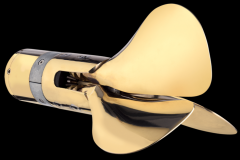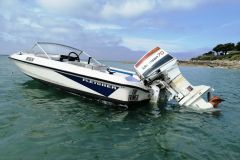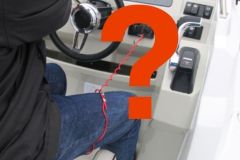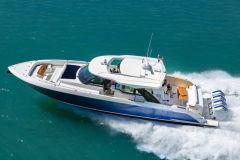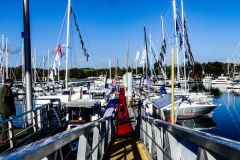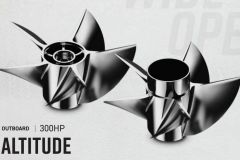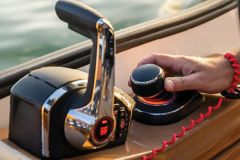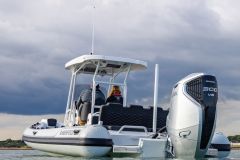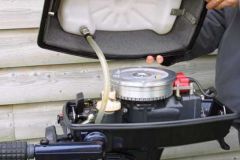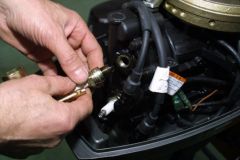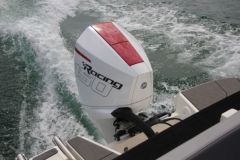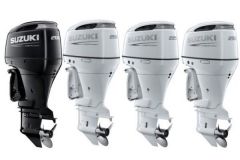Suzuki engineers are pushing the envelope to provide the best efficiency for their engines. This research is carried out in detail in terms of technical options. To discover them, you have to look at the technical data sheets and understand the inner workings of mechanics.
Offset drive head
By shifting the drive head forward, Suzuki engines avoid having the full weight of the motor on the rear of the boat. Indeed, the drive head is the heaviest part of the engine (cylinder heads, cylinders, pistons, connecting rod...). This weight distribution is important because on a boat with outboard propulsion, the weight is on the rear of the transom. Advancing the drive head avoids having to compensate with a hull with greater buoyancy.
2-stage reduction system
As the drive head moves forward, the connecting rod is no longer in line with the axis of the drive shaft. To connect the two, Suzuki has installed pinions that form a first reduction stage (the transmission shaft rotates at a slower rate than the connecting rod). Finally, as with all outboard engines, a second reduction stage is located in the hub, just before the propeller shaft.
With these 2 stages, the reduction is more important, which allows to install propellers of larger diameter for a faster acceleration. In addition, these engines maintain a propeller rotation speed even with a high load.
Lean Burn
The engines are now managed by electronics. The Suzuki's case features a program called Lean Burn that provides the right air/fuel mixture for the right sailing conditions. This offers a significant improvement in fuel efficiency, regardless of the speed range used (drag speed, cruise speed or maximum speed). This reduces fuel consumption and prevents engine fouling.
Double injector
All Suzuki outboard engines have an injector power supply. With the dual injector, Suzuki is able to dose the fuel volume and the right injection time even more precisely. This further increases power output and optimizes energy efficiency. This is strongly reflected in consumption.
Self-adjusting distribution chain
By using a chain rather than a belt, Suzuki increases the life of the distribution (less costs at the time of revisions). And to solve the problem of chain tension, the chain is immersed in an oil bath for good lubrication and is equipped with an automatic hydraulic tensioner. This ensures that the adjustment is always optimal.
Air supply with a double fin system
To operate, an internal combustion engine uses fuel, but also a lot of air. However, on an outboard, very close to the water surface, this air is often loaded with moisture, which can be harmful to combustion and the engine's longevity. Designed for the new DF350, the air intake must pass through a system of double angled fins that separate water from air. This means that the motor is only supplied with dry air, which increases its service life.
Double helix system
For larger powers, it is difficult to transmit all the power to the propeller. With the DF350, Suzuki has innovated by installing 2 propellers on the same outboard engine. These two propellers, which rotate in opposite directions, offer greater road stability and high acceleration during start-up. In addition, two propellers with a smaller diameter than a single large one limit the size of the base and the hydrodynamic drag in the water.
Selective rotation
Only one base plate for both directions of rotation: that's what Suzuki does. Whether you choose a right or left rotation for your boat, there is no need to change the base for that. Rotation and counter-rotation can be used on the same outboard motor.
Suzuki Precision Control
No more traditional mechanical cable to control the motor. Orders are now made through an electrical network. This makes cable routing easy. No more friction and mechanical resistance. Whether single or twin-engine, the cockpit can be installed anywhere on the boat without constraint.
Quiet operation
The noise of an engine is not only due to the exhaust. The noise of the air intake is also very important. Suzuki has suppressed them with a resonator that reduces outboard noise. Navigation is quieter and more comfortable.
Inclination limiter
Outboard motors are delivered with a cylinder to lift the motor when stopped. However, some transom configurations prevent the engine from being fully raised. To prevent it from hitting each lift, a tilt limiter protects the boat and the engine cowling from possible shocks.
Suzuki Troll Mode
There's the friend of the troll fishermen. This optional system allows the boat to travel at a constant speed at low rpm. Without controlling the accelerator, by adjusting the rpm with a button, you get a slow and constant speed. Ideal for trolling!
Hands-free start
With the remote control nearby (in a pocket for example), the engine starts. This discourages theft (easy with a conventional key) and does not require the key to be inserted into the switch before starting.




